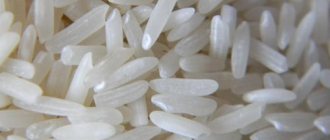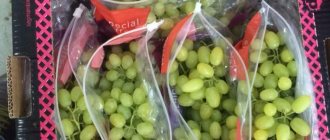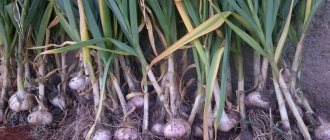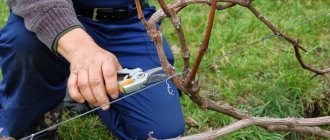How to preserve grape seedlings in winter
1. What seedlings can be stored?
Well-ripened seedlings are subject to storage. Storing vegetative seedlings or seedlings with immature growth during the winter can lead to their death. The seedlings must have labels with the name of the variety that will not deteriorate and the inscription will not be erased during storage (plastic, metal, etc.)
2. What problems may arise during storage?
Drying of seedlings, especially the roots, and the appearance of mold.
3. What are the most important indicators during storage?
The most important thing is to maintain the required temperature and humidity, and avoid over-moistening and drying out.
4. What temperature should the air be during storage?
It is necessary to maintain the temperature from 0 to +6 °C
5. What should the air humidity be?
The optimal air humidity when storing seedlings should be 75-85%.
6. What types of storage of seedlings?
The main types of storage are in the basement (cellar) and in the pit (trench).
7. How to store seedlings in the basement?
Two storage methods that we personally use: If necessary, you should treat the basement (walls, ceiling, floor) in advance (in summer) with 3% Bordeaux mixture or copper sulfate in order to protect against mold fungi. This is done every few years and repeated as necessary.
Method 1 Spread a 3-4 cm layer of sand on the floor
Place bunches of seedlings vertically along the wall close to each other and fill them halfway with wet sand. Don’t forget to put sand between the wall and the row of seedlings
Method 2 – stacking Spread sand on the floor in a layer of 3-4 cm
Lay the seedlings horizontally
Place the second row with its roots facing the first row.
Cover the roots with wet sand. If several tiers are planned for the stack, then the thickness of the sand on each layer should be 3-5 cm. The next tier is laid on top of the first, and so on. The maximum height of the stack should not exceed 1.5 m. Each layer is covered with sand. The last layer of sand is 10-15 cm. What wet sand looks like
During the entire storage period, it is necessary to check the moisture content of the sand and, if necessary, moisten it. And also ventilate and make sure there is no mold.
8. I don’t have a basement, what should I do?
As an exception, it is allowed to store seedlings in a trench (we never used it as it was unnecessary). The dimensions of the trench depend on the number of seedlings that need to be preserved; the recommended trench depth is 80-100 cm. Pour sand into the bottom in a layer of 10-15 cm, lay the seedlings in rows (tiers), sprinkling each row with wet sand. Pour a layer of sand on top so that the growth is covered by 20-25 cm, and on top of this sand - a layer of earth 20-25 cm, making a roller over the trench.
9. In the spring I took out seedlings, how can I tell if they are well preserved?
After storage in damp sand, the seedlings should have a bright green cut on the growth and elastic growth. When pruned, the roots should be cream, white or light gray in color, juicy, and elastic to the touch. After storage, before planting, seedlings need to trim the roots, refresh the top and soak in water for 12-24 hours.
10. Where seedlings should not be stored
Seedlings should not be stored in winter in warm, heated rooms, near heating devices or radiators, as well as in rooms where strong fluctuations in temperature and air humidity are possible (balconies, loggias, sheds, outbuildings, etc.)
11. And most importantly
If you doubt your ability to properly preserve seedlings, it is better to buy them in the spring.
Methods
Gardeners, based on their capabilities, use various options for winter storage of chibouks. It is difficult to create optimal conditions in city apartments, so summer residents keep chopped vines in the refrigerator. But this method is suitable only for a small amount of planting material.
Therefore, for large batches of cuttings, storage is prepared in special trenches, as well as in a cellar or basement. But in any case, regular checking of the quality of planting material will be required, if necessary, moistening and culling of damaged specimens.
In the trench
This type of storage of cuttings in winter is practiced by many winegrowers. The location for the trench is chosen on a small hill, excluding areas with close groundwater flow. In the spring, moisture should not accumulate near the storage facility, otherwise there is a high risk of it getting inside the trench.
The ditch is dug in advance, taking into account the number of cuttings to be stored. Depth - up to 90-100 cm, length - based on the size of the batch. The walls and bottom are treated with slaked lime for disinfection. A layer of calcined river sand (“pillow”) is laid, then bunches of grapes are placed. Sprinkle sand on top, then earth.
Add additional snow to the shelter and lightly compact it on top. Be sure to put an identification mark so that you can easily find the storage location in winter.
In the snow
A simple and reliable way is to put the bunches in plastic (bags, bottles) and bury them in a snowdrift. This option is only suitable for those regions where there is a lot of snow, and it lies from autumn to spring.
Cuttings for storage are cut short, into pieces no longer than 38-40 cm. It is convenient to use PET bottles, in which the cuttings will be protected from frost and excessive dampness.
In a place chosen on the site, a depression is dug and a dense “cushion” of snow is built. Its height should be at least 12 cm. Place plastic bottles with cuttings, carefully sprinkle with snow, and compact.
In the basement
If you have a dry cellar, it is easy to preserve the shoots until spring. The main thing is not a damp and clean room, a mandatory check of the vines.
Storage options:
- In plastic bags. The branches are wrapped only in the middle, leaving the ends open.
- In boxes (buckets, containers) with sawdust. To fill, take coniferous waste, pour each bunch, then lightly moisten it with water. In winter, they check the vine by carefully rearranging the bundles and swapping them.
- In boxes or boxes with river sand. Bunches of cuttings are laid vertically or horizontally, sprinkled with calcined sand. Moisten the layer with water, preventing the pipes from losing moisture. If the cellar is dry, the sand will have to be moistened every 3-4 weeks, otherwise the shoots will dry out.
A small number of chibouks are stored this way: a layer of damp sand is poured into a box, shoots are stuck in, and the top is covered with plastic wrap. The cuttings should not touch each other. The humidity and safety of the vines are checked every month.
In a refrigerator
Grape cuttings are stored well using this unusual method. Of course, this option is only suitable if there is little material. For example, the main batch is placed in the basement, and shoots of especially valuable or rare varieties are placed in the refrigerator.
You will need a 1.5-2 liter PET bottle. It is cut in the middle, a layer of sand is poured into the lower part, cuttings are stuck in, and the second half of the bottle is covered on top. Place horizontally on the shelf below or in a box where fruits and vegetables are stored. Monitor the condition of the shoots and temperature conditions. It is important to ensure stable indicators, since the buds will open when the temperature rises, and the shoots will freeze when the temperature drops.
The best recommendations on how to store grape seedlings and cuttings before planting
In order to plant grapes at your summer cottage when spring comes, you need to start preparing young plants in the fall. It is important for everyone who decides to grow grapes on their own plot to know how to preserve grape seedlings before planting. There are many ways to store grapes, and every gardener will be able to choose the most convenient one for himself.
Preparation of pipes
To prepare grape cuttings, you need to know some rules:
- The stem is cut from the lower or middle part of the fruit-bearing vine. This is a requirement.
- Before cutting, the vine must be checked for maturity. To do this, you need to bend it slightly. If the vine is mature, a characteristic cracking sound will be heard.
- Additionally, the vine is checked for maturity using regular iodine. After applying iodine to a cut of the vine, it should turn black.
- You should not choose a vine that is thick or too thin. The optimal thickness for cutting a shank is 0.7 cm.
- The length of the cuttings should be 60-70 cm. When spring comes, such cuttings are cut into several more, about 25 cm each. Each of them should have 2-3 buds.
- The pipes are harvested at the end of the growing season. It is not recommended to do such an event in spring due to the low percentage of plant survival.
It is worth noting that long-established varieties are considered the most unpretentious in propagation. Such as:
How to care and store?
To ensure good and rapid development of the grape plant, you will need to take care of the planting material even before planting it. Sliced chibouks are prepared as follows:
- First of all, the stepsons and tendrils are removed from each cutting.
- Tied in bundles. For convenience, it is recommended to attach a label to each bunch, indicating the crop variety on it.
- As a preventive measure, the bunches are sprayed with a fungicidal solution. A 3-5% solution of copper and iron sulfate or Azophos is suitable.
We will consider below how to care for seedlings and cuttings in different conditions.
In a refrigerator
Storing cuttings in the refrigerator
To store in the refrigerator, you will need to place the prepared cuttings in an opaque (preferably) plastic bag, or a cut-off 5-liter water bottle and carefully place it in the refrigerator.
The suitable temperature for storage in this way is from +2 to +4 degrees.
Experienced gardeners also advise putting a slightly damp cloth in a plastic bag or first wrapping the cuttings in cloth and then putting the bag on. This storage option is good if you don’t have a lot of cuttings.
You can store cuttings in this way in winter - until about the end of February. Then, usually, the buds still begin to grow, even in the refrigerator. Therefore, it is worth thinking about germinating them and preparing them for planting in open ground.
In the cellar
From personal experience I can say that I cannot store cuttings in the cellar, since it is very warm and they simply germinate there in advance. But, if you have a cellar with the same year-round temperature plus 2 - 5 degrees, then it is perfectly suitable for these purposes in this article. After all, you won’t constantly hear from your wife that you’re taking up space in a small refrigerator.
In principle, everything is simple here, you need to do the following:
- Purchase plastic bags and soil for seedlings.
- The soil is steamed in advance, mixed and cooled.
- The root system of young grapes is placed in a bag and soil is gradually poured in, carefully distributing the roots of the plant. At this stage, it is important to fill all the space between the roots, leaving no air gaps or bubbles.
- Make several holes in the bag to ensure air circulation.
- Moisten the substrate with a small amount of water and tie the bag to maintain the desired level of humidity.
- For storage in the cellar, you will need to tie a bag directly above the root collar of the seedling.
Under the moss
Moss is an excellent soil replacement. The advantage of this method is that the cuttings practically do not germinate even if your room temperature is a little higher than necessary. To store grape cuttings using this method, you will need to do the following:
- First you will need to prepare a box 20 cm higher than the length of the cuttings.
- Pour 15 cm of wet moss onto the bottom of the container (can be replaced with sand or sawdust).
- The next layer is to lay out tied bunches of grapes in one row, leaving a distance of 5-7 cm from the walls of the box.
- Place another layer of moss on the cuttings. Repeat this manipulation several times.
- The last (top) layer of moss must be at least 15 cm, after which the box is covered with a lid and sent for storage in the basement or cellar.
In the trench
The method of storing grape seedlings in winter in a trench or in a trench is considered one of the most common among gardeners, especially if it is necessary to preserve a fairly large number of them. I myself use this method. In order to store seedlings in the right conditions, you will need to take into account the following nuances:
- You need to choose a sunny, dry place protected from strong winds for storage.
- The length of the trench is calculated based on the number of seedlings. Each plant requires 20 cm and 20 cm between plants.
- The trench width is at least 50 cm, depth is 55-60 cm.
- You cannot dig a trench in an area where groundwater lies close to the surface, since high humidity will provoke rotting, and there is also a risk of freezing of the roots of the crop.
- If the site has heavy soils, then spring digging and adding sand and peat are required.
- I first lay sawdust at the bottom of the dug trench, maintaining a layer thickness of 15 cm.
- Before sending for storage, I remove excess leaves directly from the seedlings and place the root system in water for 6 hours, after which I inspect the root system and remove injured and weak roots.
- After the seedlings are prepared, they can be placed in a trench. The roots should face north and the tops should face south. This technique provides maximum illumination to young grapes.
- I sprinkle the plants with soil (layer thickness 20 cm) and water them abundantly.
- Before the onset of frost, the trench must be completely covered with soil and a small mound must be made above the surface of the earth.
- You can get grape seedlings only after the soil has completely thawed, approximately in April (depending on the climate).
Article on the topic: Rizamat resistant - grape variety - grapes
Rooting methods
If the grape cuttings survived the winter, then the soil is planted in the spring. However, before such manipulation, the plant is rooted, otherwise the vine will not take root. There are several ways to germinate raw materials. Before carrying out any such procedure, it is recommended to make a fresh cut on the plant.
In a plastic bottle
To germinate a plant using this method, take a plastic bottle with a volume of 1.5 liters. A hole is made at the bottom of the container through which excess liquid will drain. After this, lay out the following layers:
- expanded clay or broken brick;
- substrate or sawdust.
The last layer can be replaced with a mixture of the following products:
- peat;
- sand;
- turf land.
The plant is placed in the bottle and soil is added. The top of the bottle is covered with a plastic bag and the container is placed on the windowsill so that the sun's rays fall on the plant.
In order for the plant to take root, the soil is fed with water daily for three weeks. To do this, place the container in warm water for a quarter of an hour. Next, the bottle is placed on a pallet. As soon as water accumulates in this container, it is drained.
In water
To perform germination in water, you will need fresh spring or rain moisture. Fill the containers with liquid and place the plant so that the water reaches only 2/3 of the cutting. The raw materials are left for 3 days. If after storage the cuttings dry out too much, the soaking period is increased.
Kilchevanie
Germination using this method is carried out in a trench dug in a greenhouse. The upper part of the raw material is placed in the ground, and the lower part is left on top. As a result, the plant is affected by different temperatures. After some time, the raw material will take root. The advantage of this procedure is that there is no need for regular moisturizing.
Germination
The next step after storage is germination. To do this, the grape stems need to create an optimal temperature regime: 24 degrees in the soil and 8-13 degrees in the atmosphere. Germination can be carried out in several ways, namely:
This important procedure is described in more detail in a separate article.
Each method has its own advantages and disadvantages, which we recommend that you familiarize yourself with first. Many gardeners (including me) use special preparations for rooting plants to speed up the process of root formation.
In open ground
Depending on which method was used to root the grape cuttings, the moment of planting the crop in open ground is determined. If the root system can be seen through, for example, a transparent container in which rooting was carried out, then when the roots reach 2-3 cm in length, they are transplanted into cups or bottles with soil mixture and after 2-3 weeks into the ground.
When planting grapes (seedlings and cuttings) in open ground in the spring, you need to know the following points:
Planting cuttings in the ground
- As for the temperature regime, planting in open ground is carried out when the temperature is at least 19 degrees in the soil at a depth of 10 cm.
- Before planting grapes in open ground, it is necessary to thoroughly prepare the site by applying organic and mineral fertilizers. Next, they begin to dig holes for the grapes and water them generously with water.
- A mandatory measure for beds with grapes is mulching around the sprouts using peat or wet sawdust.
In order to grow grapes, it is important to know not only the rules for caring for the crop, but also all the nuances regarding the storage of seedlings and cuttings. I tried to share with you my knowledge in this matter. And if you follow all the recommendations described above, then a good and rich grape harvest is guaranteed.
Blank
Cuttings or stems are necessary for obtaining planting material, as well as for grafting. They represent a piece of young annual growth of grape shoots; they can be lignified (ripened) and green.
Beginning gardeners often confuse seedlings and cuttings. The difference is significant: 1-2 year old plants with a root system and growth, used for planting in a permanent place, are seedlings.
The scheme is simple: winegrowers prepare cuttings in the fall, save them until spring, then root them and then plant them in the ground. The options are different. The summer resident chooses the most convenient for himself from the following methods:
- rooting, growing in glasses at home, moving to school;
- rooting and immediately after this (if weather conditions permit) planting in the school.
Regardless of what kind of grape seedling (one- or two-year-old) you want to get, you first need to prepare the required number of cuttings. Before planting in the spring, chopped chibouks can be stored in the cellar, basement, or refrigerator. The choice of location depends on the capabilities of the owner.
Autumn harvesting of grape cuttings
Propagation of grapes by cuttings is a vegetative method. A young plant is grown from part of an adult shoot. The most suitable cuttings are from a one-year-old vine that is already bearing fruit. They are called Chubuki. Cuttings may be woody or green. If you follow the rules, the process will not seem too laborious.
In the fall, when the leaves have already fallen and frosts have not yet begun, you need to choose a healthy grapevine and trim its top part. The diameter of the vine should be up to 1 cm. Unripe tops, tendrils, and leaves must be removed from cut shoots, and be sure to preserve 4 eyes.
The cut from above should be made a few centimeters above the top bud. The lower part of the shoot is cut in three places so that the cut is about three centimeters in length. This is necessary to ensure proper metabolism for the cuttings after planting in open ground. Be sure to use a sharp knife and make the cut at an angle. Gardening tools for carrying out the procedure for harvesting cuttings must be prepared in advance and processed in order to avoid the development of diseases.
When preparing cuttings of different grape varieties for storage, it is necessary to label them and then collect them in bunches. In this form they will not infect each other. Later, the cuttings are placed in water for a day, treated with a solution of copper sulfate (5%) and left to dry completely. Copper sulfate will disinfect the branches and fill them with useful substances that will help them survive the winter. The finished cuttings are placed in a plastic bag or covered with plastic wrap and hidden for storage. Chubuki must get stronger over the winter so that they are ready for planting in early spring.
Cutting cuttings
Cuttings must have live eyes (buds) and not dried or damaged ones. Therefore, planting material must be prepared before the autumn frosts intensify, which in some years occur as early as late September - early October. Some winegrowers believe that the likelihood of bud damage increases towards the end of leaf fall, so they begin to harvest chibouks early in the fall. Grapes that are grown in a greenhouse have a much longer supply of time.
The grape bushes from which cuttings are supposed to be taken are marked in advance. In the fall, it is easy to confuse where one variety or another was grown, especially in a large vineyard. There are several requirements for mother bushes. First of all, they must be healthy and productive, as well as interesting for further reproduction.
In the fall, cuttings are taken from the mature part of the vine. It is easy to recognize not only by its color. It should be warm. I sometimes show my friends a trick. I suggest placing your hand around the green part of the cutting and the part that has developed bark with the characteristic color of darkened straw. The green (unripe) part of the shoot will be cold even in summer, and the ripened part will be warm.
It is better not to use shoots and fat shoots for cuttings.
Cuttings must be freed from leaves, shoots and tendrils. Chubuks with a diameter of at least 1 cm are more likely to survive the winter. Thin cuttings are worse stored in winter. I have heard the opinion that the bushes grown from them are weaker. For me, it is desirable that the harvested parts of the vine have at least 5 internodes. It’s great if you can save parts of the vine in winter, 6 to 8 internodes long, so that later you can cut out the healthiest part. Many winegrowers consider a cutting length of 3–4 buds or less to be quite sufficient.
The cuttings should immediately be grouped by variety. They are easy to confuse, so labels are attached to the bundles. Not paper ones, which can cause the spread of mold and rot, but plastic, metal or made of foil. The more information on the labels, the better.
Cuttings can easily be spoiled if they are not treated within 24 hours. If there is any delay, it is better to at least temporarily bury the cuttings or wrap them in a plastic bag.
Selection of planting material
Planting material must be chosen carefully; the success of planting depends on its quality. The cuttings must be strong and healthy. Therefore, you need to carefully examine the vine. The color of the shoots should be brown-green, uniform in color. There should be no rot, stains, cuts or damaged areas on the shoot.
Article on the topic: Ansonica - grapes
The diameter of the stem should be from 0.6 to 1 cm. The length can be up to 60 cm. If the shoot is too short, it may die, it will not have enough nutrients. Long shoots of grape cuttings are difficult to store. Be sure to keep up to 4 eyes on the shoot, this will allow the plant to take root better and immediately enter the development phase after transplantation.
Autumn work
Gardeners are preparing for the next planting season individually. Some believe that it is necessary to harvest material in the first months of autumn before the onset of frost, while others harden seedlings at sub-zero temperatures. It is best to take into account the climatic conditions of a particular region. The planting material should be such that it can easily survive the winter and take root after planting in the spring.
You also need to choose the right vine. There are several recommendations for this:
- only those varieties that are needed next year are suitable;
- You should not choose fatty and overgrowth branches, it is better to trim fruit ones;
- optimal thickness - up to 1 cm;
- the length depends on the number of buds.
The thickness of the vine is important. Thin material will not survive the winter; it will simply freeze. And thick branches fatten, so they are not suitable as cuttings. Therefore, segments from 0.5 to 1 cm are suitable. You need to choose long vines that have 5-6 buds. They can be trimmed to a suitable size in the spring. Although 3-4 buds are enough to plant a cutting. Then the grape cuttings are prepared for winter storage.
How to store grape seedlings in winter before planting
During long-term winter storage, the plant quickly weakens, losing half of its nutrients, and gradually they become unsuitable for planting. The main task during storage is to minimize losses. Grape cuttings can be stored in the refrigerator or in the basement. You can bury the cuttings in the ground. Darkness and low temperature slow down the processes of growth and development, reducing the consumption of nutrients.
Storage in a cellar or basement
Chubuki can be stored in the basement, only the temperature in it must be constant and not fall below zero degrees. Otherwise, the air will become very cold and the vine will freeze. The temperature should not be allowed to rise above +4 degrees, otherwise the buds will swell and bloom. If you regularly ventilate the room or equip it with good ventilation, you can achieve good temperature conditions and optimal humidity.
The cuttings themselves also need ventilation. Be sure to make several holes in the plastic film that is used to wrap the cuttings. About once a month, the package must be unwrapped and the cuttings inspected to prevent mold from forming. If it appears, wipe the cuttings with a napkin soaked in copper sulfate. Cuttings can sometimes dry out, then you need to moisten the vine.
You can use wet sand or pine sawdust. They are placed in a plastic bag and the cuttings are placed there. This will help reduce nutrient loss and retain moisture.
Cold storage
How to preserve the vine at home before planting? A small number of cuttings can be stored in the refrigerator. The main thing is that the length of the vine does not exceed half a meter. Bags of cuttings are placed on the refrigerator shelves at some distance from each other, or they can be stored in a plastic bottle, as in the photo.
The chubuks are cut, treated with water and vitriol, then wrapped in thin cloth, and in this form they are placed in plastic bags. About once a month, the bundles are unrolled to moisten and treat with copper sulfate.
Trench storage
Prikop is the simplest and least labor-intensive way to store cuttings. It is necessary to dig a shallow hole, place the shoots in it, and cover it with earth. The main thing is to choose a place where the water falls and does not stagnate there. Otherwise, the cuttings will rot. Dry soil protects well from diseases, mold, and retains nutrients.
Storage
Storing grape cuttings and seedlings leads to a loss of 50% of nutrients, which often makes them too weak and unsuitable for planting. For this reason, your main goal is to keep the loss of carbohydrates and vitamins to a minimum.
The lower the temperature in the cellar, the slower the vital activity of plants and the lower the consumption of stored substances.
Experts believe that 0-4°C is the optimal temperature at which the vine can be successfully stored until mid-March.
Temperatures from 0 to 4°C allow you to preserve those beneficial substances in wood that are necessary for the formation of roots and shoots. If the air is too cold, the vine begins to dry out rapidly. That is why it is undesirable to harvest vines in the spring from bushes that have stood uncovered all winter. As a rule, few buds sprout from them.
If the temperature in your cellar exceeds +4°C, then the vine buds may swell and begin to bloom. You can prevent this by artificially lowering the temperature through constant ventilation or increasing humidity.
Storing vines in polyethylene.
So, how to organize the storage of vines in the cellar? Below we will present the three most popular and simplest methods.
- Lightly moisten the seedlings and cuttings by sprinkling them with water and pack them in plastic bags with several holes for ventilation. Once a month, open them and inspect them carefully. If mold has formed on the vine, carefully remove it with a soft cloth soaked in a solution of copper sulfate. If the vine is dry, moisten it again.
- Another popular method is to use wet sand or pine sawdust. Their addition to the package guarantees constant hydration of the cuttings and a reduction in carbohydrate consumption.
- The easiest way is to store seedlings and cuttings in a trench. To do this, you need to dig a shallow hole, place the workpieces in it and cover it with earth. Dry soil will prevent the development of mold and fungal diseases, and will also preserve the beneficial substances contained in grape wood.
How to prepare grape cuttings in spring
You can use green cuttings, which are harvested in the spring. This should be done 14 days before the flowering phase. You need to choose healthy branches, cut the cuttings, keeping 2 eyes on them. You need to cut the leaf blades in half. It is better to carry out the harvesting procedure in the morning, because at this time the plant is most saturated with moisture.
Then the cuttings are immersed in water for a day and covered with a cloth. In the meantime, take containers, put drainage from stones in them, soil for grapes, fertilizing and sand on it. The cuttings are placed at a depth of four centimeters. There should be a distance of about 10 cm between them.
The containers are covered with film, this will maintain the desired temperature and humidity. During the month, soil humidity is maintained at 100%, temperature up to 30 degrees, and air humidity at 85%. After a month, watering is reduced, the film is removed, the plant needs to be accustomed to natural conditions. At the end of summer, the chibouks are treated with fungicides to prevent the development of diseases. The cuttings are left in this form for a year in order to begin replanting next spring.
Typical mistakes when storing grape cuttings
- It is important that the shoots for pruning are strong and healthy. The thickness of the cuttings should be about 8 mm. It is recommended to cut the middle part of the vine; this is where a large amount of nutrients and healthy buds are concentrated.
- Cuttings often die due to lack of moisture. Therefore, they are soaked in water for 2 days.
- To protect shoots from diseases, they are treated with a solution of copper sulfate.
- If you plan to store cuttings in soil, you need to prevent rotting. It is recommended to mix the soil with sand.
Sources:
https://vinograd.info/stati/vinogradarstvo/kak-sohranit-sazhency-vinograda-v-zimnee-vremya.html https://vinodelnya.com/vyrashchivaniye/posadka/kak-sohranit-sazhency-vinograda-do-posadki / https://proposadki.ru/yagody/vinograd/kak-hranit-sazhentsy-vinograda-zimoj











